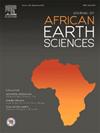埃及尼罗河三角洲Disouq油田Kafr El Sheikh和Abu Madi含气储层特征和相建模:综合岩石物理、压力和地震研究
IF 2.2
4区 地球科学
Q2 GEOSCIENCES, MULTIDISCIPLINARY
引用次数: 0
摘要
Kafr El Sheikh (KES)和Abu Madi地层是尼罗河三角洲潜在的产气储层之一,因此对其进行了大量的表征工作。根据西北沙漠地区Disouq油田4口井的全套常规测井资料,计算了这2个地层的岩石物性和含油气潜力。当岩石饱和度、中子密度和M-N图综合在一起时,表明所研究的两个储层主要由页岩组成,其中一些砂岩透镜体和叶状体可能是潜在的储层。根据岩石物理资料,进一步将KES组划分为KES IIIA、KES IIIB、KES IIIC和KES IIID。Abu Madi组(7.77 m <;净支付1372万,20.8%∅e & lt;25.8%, 34.4% <;Sw & lt;51.8%, 20.3% <;Vsh <22.6%)和KES组(1.98 m <;净支付10.0亿美元,23.1%∅e & lt;25.3%, 29.5%;Sw & lt;42.4%, 29.0% <;Vsh <32.0%)表明这两个储层的潜力很大。地震资料显示,该区存在一条东西向的4向倾闭和一条北向南向的正断层与之相交,在其上部地块形成背斜。来自重复地层测试(RFT)的压力数据帮助计算出DSQ 1-3和DSQ 1-5井在7296英尺和7850英尺深度的天然气和含水层之间的自由水位(FWL)。在DSQ-2X井中,发现水的深度较浅(1943-2170米深度的上部隔室),而两个较深的含气层(2170-2230米和2230-2270米深度的中下部隔室),这意味着有三个独立的隔室。测井和地震数据之间的整合,可以更详细地描绘油田复杂的构造环境,并详细描述其储层和岩石物理性质。该研究适用于尼罗河三角洲和其他类似的推进型河流三角洲中主要存在的类似的4向倾闭。非洲和全世界的三角洲和近岸地区的类似序列可以利用应用的工作流程。本文章由计算机程序翻译,如有差异,请以英文原文为准。
Reservoir characterization and facies modeling of the gas-bearing Kafr El Sheikh and Abu Madi reservoirs in the Disouq Field, Nile delta, Egypt: An integrated petrophysical, pressure, and seismic study
Kafr El Sheikh (KES) and Abu Madi formations are among the potential gas-producing reservoirs in the Nile Delta, promoting numerous efforts to characterize them. Based on a full set of conventional well log data from four wells in the Disouq Field in the northwestern Desert, the petrophysical properties and hydrocarbon potentiality of these two formations were figured out. When litho-saturation, neutron-density, and M-N plots are integrated together, they show that the two studied reservoirs are mostly made up of shale with some sand lenses and lobes that could be potential reservoirs. We further subdivide the KES Formation into KES IIIA, KES IIIB, KES IIIC, and KES IIID based on the petrophysical data. The petrophysical parameters of both the Abu Madi Formation (7.77 m < net-pay <13.72 m, 20.8% < ∅e < 25.8%, 34.4% < Sw < 51.8%, and 20.3% < Vsh <22.6%) and the KES Formation (1.98 m < net-pay <10.0 m, 23.1% < ∅e < 25.3%, 29.5% < Sw < 42.4%, and 29.0% < Vsh <32.0%) indicate a high potentiality for these two reservoirs. The seismic data revealed the existence of an E-W trending 4-way dip closure and a major N-S normal fault that intersects the field, forming an anticline in its upper block. The pressure data from the repeat formation tester (RFT) helped figure out the free water level (FWL) between the gas and water aquifer at depths of 7296 ft and 7850 ft for the DSQ 1–3 and DSQ 1–5 wells. In the DSQ-2X well, the water is found at a shallower depth interval (upper compartment at 1943–2170 m depth interval) than in two deeper gas-bearing reservoirs (middle and lower compartments at 2170–2230 m and 2230–2270 m depth intervals), which means that there are three separate compartments.
The integration between the well log and seismic data enabled more detailed delineation for the complex structural setting of the field and detailed characterization for its reservoir and petrophysical properties. This study is applicable to the similar 4-way dip closure, which is dominant in the Nile Delta and other similar prograding river-dominated deltas. Analogous sequences in deltaic and nearshore areas in Africa and worldwide can utilize the applied workflow.
求助全文
通过发布文献求助,成功后即可免费获取论文全文。
去求助
来源期刊

Journal of African Earth Sciences
地学-地球科学综合
CiteScore
4.70
自引率
4.30%
发文量
240
审稿时长
12 months
期刊介绍:
The Journal of African Earth Sciences sees itself as the prime geological journal for all aspects of the Earth Sciences about the African plate. Papers dealing with peripheral areas are welcome if they demonstrate a tight link with Africa.
The Journal publishes high quality, peer-reviewed scientific papers. It is devoted primarily to research papers but short communications relating to new developments of broad interest, reviews and book reviews will also be considered. Papers must have international appeal and should present work of more regional than local significance and dealing with well identified and justified scientific questions. Specialised technical papers, analytical or exploration reports must be avoided. Papers on applied geology should preferably be linked to such core disciplines and must be addressed to a more general geoscientific audience.
 求助内容:
求助内容: 应助结果提醒方式:
应助结果提醒方式:


